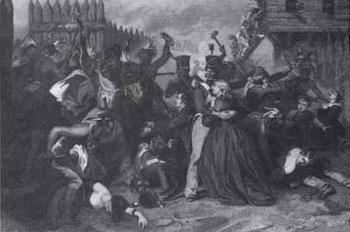|

At the start of the Creek Civil War, settlers north of Mobile, particularly mixed-blood Creeks from the lower towns, began to take refuge with the American settlers in the stockades of Fort Mims. About 550 settlers, including 175 armed militia, were gathered at Fort Mims, which was located about 35 to 45 miles above Mobile, on the eastern side of the Alabama River. Upon learning that Peter McQueen's party of Red Sticks (so-called for the red, painted sticks they carried into battle) was in Pensacola obtaining arms from the Spanish, Major Daniel Beasley and Captain Dixon Bailey led a disorganized force to intercept the Red Sticks. The resulting confrontation is known as the "Battle of Burnt Corn".
Immediately after Burnt Corn, Peter McQueen gathered a party of about 800 to a 1000 warriors to strike at the mixed-blood Creeks at Fort Mims. One of McQueen's strongest allies, William Weatherford, attempted to talk the Red Sticks out of attacking, because he feared for the lives of his family members who had taken refuge in the fort. Weatherford eventually agreed to take part in the attack, with the hopes of preventing a slaughter, and to seek vengeance upon his personal enemy, Captain Dixon Bailey.

1845 engraving of the massacre at Fort Mims,
which led to the Battle of Horseshoe Bend. Photo from the book, Encyclopedia of American Indian Wars, by Jerry Keenan.
The Battle
Although Beasley, the commander, maintained that he could "maintain the post against any number of Indians," the stockade was poorly-defended and, at the time of the attack, one of the two gates was partially blocked open by drifting sand.
On the 29th of August, 1813, two Negro slaves who were tending cattle outside the stockade, reported that "painted warriors" were in the vicinity. However, mounted scouts from the fort found no signs of the war party, and Beasley had the second slave flogged for raising a "false alarm".
The attack occurred the next day during the mid-day meal, when no American scouts were out. The "Red Sticks" rushed the fort and tomahawked Beasley, who was trying to close the blocked gate. They then seized the loopholes and the outer enclosure. The settlers under Dixon Bailey held the inner enclosure, and fought on for a time. However, the Red Sticks finally set fire to a house in the center, which spread to the rest of the stockade. The warriors then forced their way into the inner enclosure and, despite attempts by William Weatherford, massacred most of the mixed-blood Creeks and white settlers. As the fever-pitched emotions of battle evaporated, 500 people were found dead, and 250 scalps had been taken. Most of the Negros were "spared", to become slaves of the Red Sticks. About 15 persons escaped, including Bailey, who was mortally wounded.
Results
The Red Sticks' victory at Fort Mims spread panic through the Southeastern United States frontier. The massacre marked the transition from a civil war within the Creek tribe (Moscoge), to a war between the United States and the Red Stick warriors of the Upper Creek. Since Federal troops were occupied with the Northern front of the War of 1812, Tennessee, Georgia, and the Mississippi Territory mobilized their militias to move against the Upper Creek towns that had supported the Red Sticks' cause. After several battles the Battle of Horseshoe Bend ended the Creek War.
Communuties and Related Links
|


